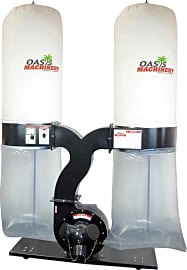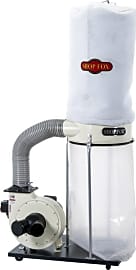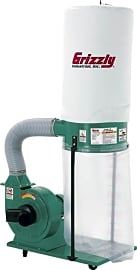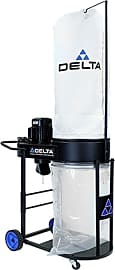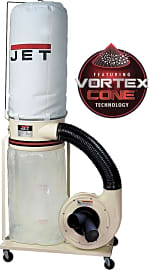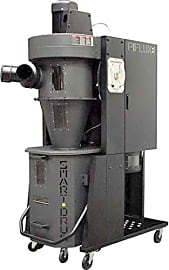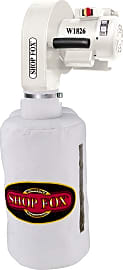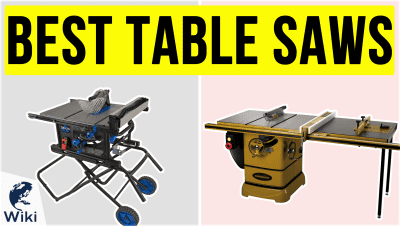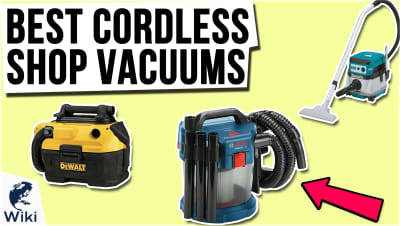The 10 Best Dust Collectors

This wiki has been updated 36 times since it was first published in October of 2016. A dust collector might not be the most exciting toy you’ll ever add to your collection, but if you wish to improve the quality of the air in your workshop or factory, you need to consider installing one of these handy machines. Our selections can remove particulate matter from the environment quickly and efficiently, providing for a safer and more comfortable workspace. When users buy our independently chosen editorial picks, we may earn commissions to help fund the Wiki.
Editor's Notes
February 10, 2020:
During this round of updates, while all of our previous selections managed to maintain their positions, we still found room to integrate a few new options: the Oasis Machinery DC5000 Heavy Duty and Baileigh DC-2100C are both 220-volt options with impressive suction capacities of 2,760 cubic feet per minute and 2,111 cubic feet per minute, respectively. The Laguna Tools P-Flux:1 MDCPF15110 is a 1.5-horsepower offering that’s set up with useful LED indicators to let users know when it’s time to empty its dust drum or change its filter. We also added some new special honors to our rankings, primarily aimed at industrial-scale operations with big budgets and lots of dust-generating equipment.
A few factors to consider for this category:
Power: As far as this goes, more is better (although it often comes with some collateral noise pollution). While a given model’s horsepower rating or impeller size can give you some decent clues in this respect, the metric you really want to be looking for is suction capacity, which is typically measured in cubic feet per minute (CFM). Smaller units with lower suction capacities – like the Shop Fox Wall that sports a 537-CFM rating – can be suitable for hobbyists looking to service a single saw, while larger machines – like the Baileigh DC-2100C that boasts a 2,111-CFM rating – can be powerful enough to collect dust from multiple workstations simultaneously.
Capacity: For casual users who plan to have this unit running infrequently, this might not be the most important consideration. But for full-time professionals who have saws cutting for eight to 10 hours a day, stopping frequently to empty your dust drum or bag can be a major annoyance. Machines with lower collection capacities – like the Delta Power Equipment Corporation 50-767T2 that has a modest, 1.7-cubic-feet dust bag – sometimes have the benefit of a smaller footprint, while models with better holding abilities – like the Oasis Machinery DC5000 Heavy Duty that can store more than 8.4 cubic feet of dust – are likely to take up a bit more space.
Portability: While the massive size of some the industrial models in this category makes them permanent installations by default, most of our selections include some provisions for portability. Casters seem to be somewhat standard issue for these rankings, but the Delta Power Equipment Corporation 50-767T2 gets a nod for including two eight-inch wheels in its design, for your rolling convenience. Although the Shop Fox Wall doesn’t have much to offer in the way of wheels, it is a wall-mountable unit – so moving it around might be less of a concern if you never need to get it out of the way.
A note on safety:
Dust-collection systems are well known for generating static electricity that can accumulate within the unit itself, or along the interior and exterior of non-conductive ducting that runs back to it. In order to neutralize the danger presented by the fire hazards these charges create, it’s imperative that proper grounding and bonding practices be observed during equipment installation. Consult a reputable, licensed electrician to ensure that your installation is up to code before you begin dust collection.
Special Honors
Laguna Tools While the company does manufacture light-duty options that are suitable for hobbyists and smaller shops, their line of industrial dust collectors absolutely dwarf those offerings. Intended for serious professionals with lots of room to spare, these models come with high suction capacities and price tags. lagunatools.com
Donaldson Filtration Solutions Headquartered in Minneapolis, Minnesota and in business for over a century, this company has dust extraction solutions for outfits of all sizes, advertising units with suction capacities that span between 500 CFM and 135,000 CFM. donaldson.com
Choosing The Best Dust Collector
Motor power and suction will be another deciding factor for some users.
Choosing the best dust collector for any given job site is a matter of deciding which factors are most important and covering them as best as possible. The loudness of the unit will be a determining factor for some. In an industrial environment with many other machines in operation, the sound of an additional machine will not make much of a difference. That is unless the addition of the machine will raise the noise level above the occupational safety levels defined by OSHA. In a small wood shop where the phone is often ringing with customer inquiries, the continuous noise from a dust collector may make hearing the phone ring or talking on it much more difficult. Choosing a quieter dust collector may be helpful in these situations rather than having to turn the machine on and off every time you need to hear.
Different processes will undoubtedly create different-sized particles, and being aware of the effective micron size of the dust collector will be critical in choosing which to use. For instance, while a five micron filter is comfortable for collecting most of the dust from a wood saw, it may not be enough for extra-fine particles created by welding equipment. The space the dust collector occupies will also be a big factor. Many dust collectors are designed to be close to the machines after which they will clean up. In a small shop, there may not be enough floor space to keep multiple units like this. These situations may call for a wall-mounted dust collector.
Motor power and suction will be another deciding factor for some users. If a dust collector is intended for use with multiple machines at once, it will need to have a strong motor to provide enough suction for all the tubes leading into it. This also makes a difference in how much tubing can be used. In general, the farther away the machine is from the dust collector, the more suction will be required to properly remove particles.
Benefits Of Having A Dust Collector In The Shop
Dust collectors can increase efficiency, reduce labor, and enhance safety wherever they are. Many government regulations are put in place to make sure dust emissions are always kept at relatively safe levels. These emissions have a direct impact on the safety of the site and workers involved. Depending on the industry that workers are in, the air may be filled with wood particles, metal, glass, synthetic dusts, or even chemicals. Workers may inhale many of these particles, causing numerous health concerns. The particles may also settle on equipment, and pose a threat to anyone who stirs them up. Using a dust collector is an integral part of hazard prevention in the workplace.
Dust particles in the air can clog the fans, making them unable to cool the motor.
Using a dust collector also keeps the equipment in the shop safe. Most equipment runs off motors that are cooled by fans to prevent overheating. Dust particles in the air can clog the fans, making them unable to cool the motor. Dust may even get past the fan and into the small moving parts of the motor itself. This creates the potential for mechanical failure, and in some cases dangerous malfunction.
High concentrations of combustible dust pose a real risk to operations of almost any size, as this dust is fuel for fires. This is the missing link in the fire triangle present in any workshop. Motors and power sources provide ignition, the oxygen in the air can fuel a fire once it starts, but combustible material is the real danger. Woodwork is a common creator of a combustible dust, but many industries are at risk of fire or explosion. Materials like plastics, rubber, and some metals can also create a hazard. Food dust from sources like sugar, flour, starch, and some spices may be enough fuel for a fire to occur. Buildup of these particles in the shop and air vents can also provide fuel for a secondary explosion once the initial fire starts up. Using dust collectors helps reduce the possibility of a fire or explosion.
Should You Use A Dust Collector Or An Air Filter?
Choosing between a dust collector and an air filter can depend on how they will be used in the work environment. There are a few key aspects of each that are crucial to understand. There is a big difference between work dust created by a machine and the particles an air filter is designed to pull from the environment. Workplace dust consists of solid particles that are produced from processes which fracture or disintegrate objects, such as grinding, crushing, or sawing. Each process will create a different type of dust. Some dust particles are heavy, and will settle on equipment, tables, and floors. Other processes create tiny aerosol particles that can often remain suspended in the air for long periods of time.
Likewise, no matter how many dust collectors are used in the workplace, they will all miss microscopic particles that some air filters are designed to catch.
Dust collectors are the ideal way to vacuum air from various workbenches and catch any large dust particulates that are released from these processes. For example, the particles expelled from operating a table saw should be immediately collected by a dust collector, not filtered with the ambient air filter. An air filter would be overloaded if it was used to filter heavy particles like these. This would lead to high costs and a lot of downtime spent repairing and replacing the filtration system.
Likewise, no matter how many dust collectors are used in the workplace, they will all miss microscopic particles that some air filters are designed to catch. This is because air filters are made specifically to trap particles that will pass right through most dust collectors. Air filters are designed to remove particles as large as visible dusts and pet dander, and as small as some microscopic pathogens. In many applications, the broad range of possible indoor particles makes it difficult for all of them to be controlled by one filtration source. It is not a matter of one or the other in many cases. Both machines play key roles in keeping the work area safe for all whom enter.


